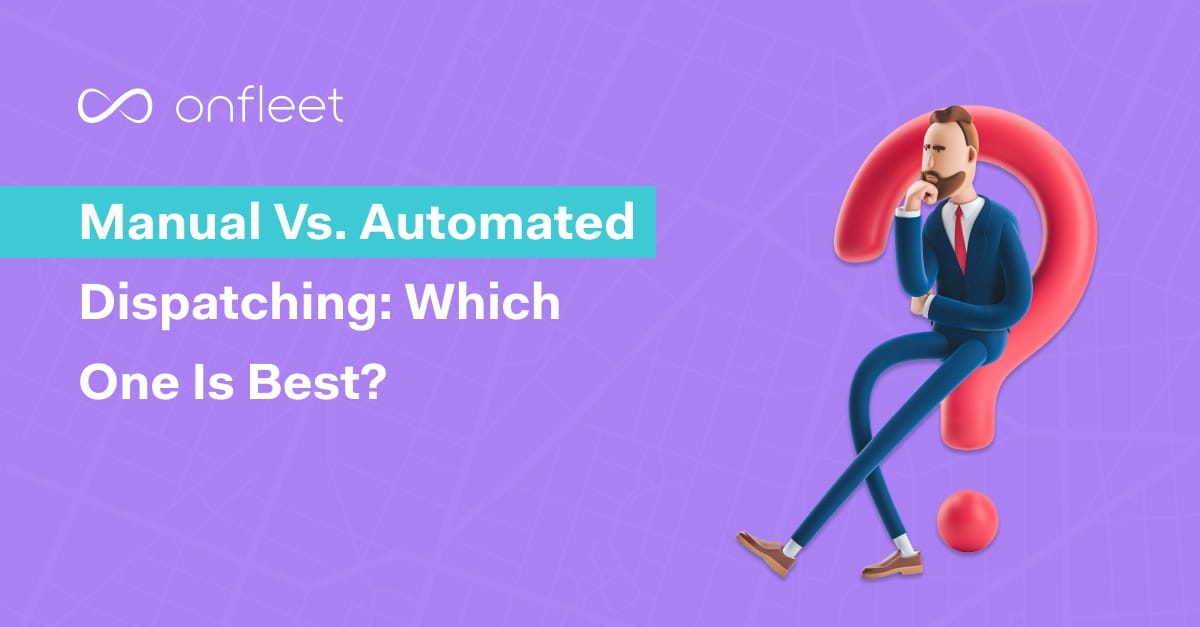
In the fast-paced world of delivery services, ensuring efficient and timely dispatch management is crucial. As businesses strive to meet the growing demands of their customers, the methods of dispatching have evolved significantly. In this blog, we'll explore the journey of dispatch management over the years, dive into the differences between manual and automated dispatching, and discuss why businesses are increasingly adopting automated solutions like Onfleet. Let's discover the best approach for your dispatching needs.
The Evolution of Dispatching Methods Over the Years
The demand for swift and reliable deliveries has been on the rise, driven by the expectations of today's consumers. From traditional manual methods to advanced automated solutions, dispatch management has come a long way.
This evolution has been fueled by the need for streamlined processes, reduced errors, and increased efficiency.
Understanding Dispatching: Manual vs. Automated
Dispatching involves coordinating and assigning tasks to delivery personnel, ensuring that goods reach their destinations promptly. Before we explore the differences between manual and automated dispatching, let's take a moment to understand the essence of dispatch management.
Dispatch management is the logistical heartbeat of any operation involved in the timely delivery of goods or services. At its core, dispatch management is the strategic coordination and optimization of resources to ensure that tasks, typically deliveries or service assignments, are efficiently assigned and completed. This multifaceted process involves planning optimal routes, assigning tasks to the right personnel or vehicles, and adapting dynamically to real-time changes such as traffic conditions or urgent requests. The aim is to maximize operational efficiency, minimize costs, reduce errors, and enhance overall customer satisfaction.
Dispatch management serves as the nerve center, orchestrating the intricate dance between resources, logistics, and technology to streamline processes and deliver results in a fast-paced and demanding business environment. Whether executed manually or through automated solutions, effective dispatch management is pivotal in meeting the heightened expectations of modern consumers for swift and reliable services.
The Primary Differences Between Manual and Automated Dispatching
Manual dispatching relies on human decision-making and coordination. It involves using pen and paper or basic software to organize routes and assign tasks.
On the other hand, automated dispatching leverages cutting-edge technology to optimize routes, assign tasks dynamically, and provide real-time tracking automatically.
Pros and Cons of Manual Dispatching
Pros:
- Familiarity:
- Pro: Manual dispatching methods are often familiar to staff, requiring minimal training.
- Pro: Easy implementation and quick adoption by employees.
- Low Initial Costs:
- Pro: Minimal upfront investment in software or technology.
- Pro: Suitable for small businesses with budget constraints.
Cons:
- Inefficiency:
- Con: Prone to errors in route planning and task assignment, leading to delays.
- Con: Limited ability to adapt to real-time changes, affecting overall efficiency.
- Limited Scalability:
- Con: Becomes challenging to manage as the volume of deliveries or service requests increases.
- Con: Increased risk of human errors and logistical challenges with a growing workload.
Pros and Cons of Automated Dispatching
Pros:
- Efficiency:
- Pro: Optimizes route planning, ensuring the most efficient paths for deliveries.
- Pro: Dynamically assigns tasks based on real-time data, reducing idle time and improving overall operational efficiency.
- Accuracy:
- Pro: Reduces errors in dispatching, leading to improved delivery times and customer satisfaction.
- Pro: Real-time tracking and analytics enhance visibility, allowing for better decision-making.
Cons:
- Initial Costs:
- Con: Higher upfront investment in software, technology, and implementation.
- Con: Might be a barrier for small businesses with limited budgets.
- Learning Curve:
- Con: Requires training for staff to adapt to new systems and technologies.
- Con: Temporary decrease in productivity during the transition period.
- Dependency on Technology:
- Con: Reliance on technology means disruptions in case of system failures or technical issues.
- Con: Continuous updates and maintenance are necessary to ensure optimal performance.
- Customization Challenges:
- Con: Some businesses may find it challenging to customize automated solutions to fit specific workflows.
- Con: Initial setup may require thorough understanding and customization to meet unique business requirements.
In summary, while manual dispatching has its advantages in terms of simplicity and low initial costs, the drawbacks in terms of efficiency and scalability make it less viable for businesses with growing demands. Automated dispatching, although requiring a higher initial investment and a learning curve, offers unparalleled efficiency, accuracy, and adaptability, making it a strategic choice for businesses aiming to thrive in the competitive landscape of delivery services.
Why Businesses are Shifting Towards Automated Dispatching
As the shortcomings of manual dispatching become apparent, businesses are increasingly recognizing the benefits of automation. Automated dispatching not only enhances efficiency but also improves accuracy, customer satisfaction, and overall operational performance. The shift towards automation is a strategic move to stay competitive in the modern business landscape.
How Software Like Onfleet is Revolutionizing Dispatch Management
Onfleet is at the forefront of revolutionizing dispatch management with its advanced software solutions. It leverages state-of-the-art technology to optimize routes, provide real-time tracking, and offer insightful analytics. The intuitive interface ensures seamless integration into existing workflows, making it a valuable asset for businesses looking to elevate their dispatch management.
How Onfleet Can Help You Transition from Manual to Automated Dispatching
Transitioning from manual to automated dispatching may seem daunting, but Onfleet simplifies the process. With user-friendly interfaces and comprehensive training, Onfleet empowers businesses to make a smooth transition. The benefits of enhanced efficiency, reduced errors, and improved customer satisfaction make the shift well worth it.
In the dynamic world of dispatch management, the choice between manual and automated approaches can significantly impact a business's success. As we've explored, the pros of automated dispatching far outweigh the cons, making it a strategic investment for businesses aiming to thrive in the competitive landscape. To experience the transformative power of automated dispatching, start your free trial with Onfleet today. Streamline your operations, delight your customers, and stay ahead of the competition.
